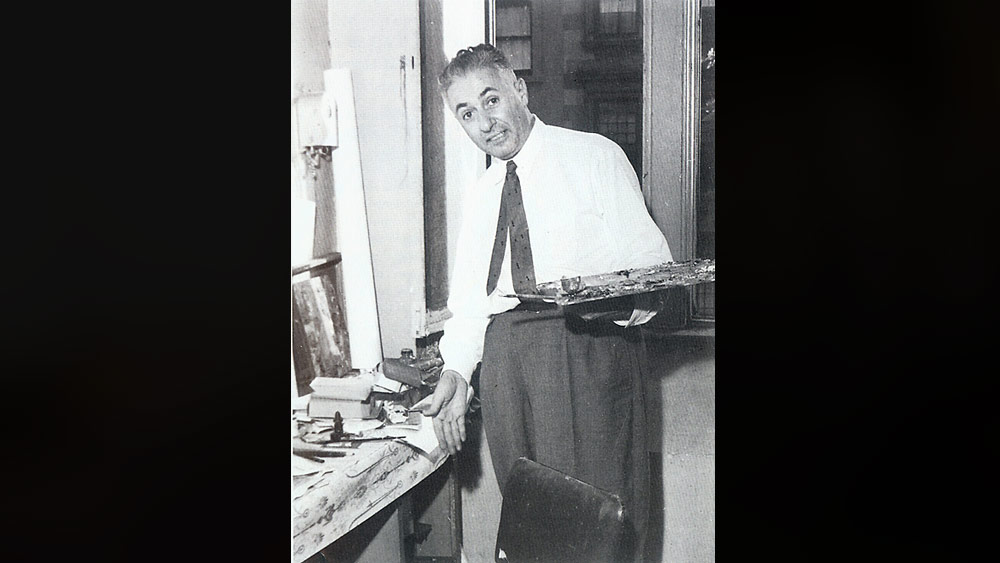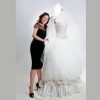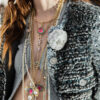A strong creative personality who does not hesitate to constantly question himself
In the aesthetic sense, the soul is the principle that breathes life to the canvas, allowing the breath to animate the material, transforming the artist into a creative power, in a name: Saliba Douaihy. This initiated, with the privilege or the supreme power to create, mark of a form of spirituality, the canvas being now the mediator, which allows the mystical and transcendental inscription of the painter. Trace the route of his life, is to enter a universe where shimmering colors, light, life, are close together, is to be immediately impregnated by a living legend. It is in Ehden, this small town of Zgharta, that was born on September 14th, 1912 Saliba Douaihy. His childhood permeates with this mythical world that becomes for him the symbol of a form of spirituality, the sacred place of childhood, a valley full of history and meditation. In the wake of his vocation, about sixteen, his father takes him to Beirut and entrustshis initiation, to the great master of painting, Habib Srour. Heconnects the boy to his commands of pictorial wall paintings. The young Saliba worked under his supervision for 4 years, from 1928 to 1932. This talented young man, motivated by a desire to learn, received a grant from the Lebanese government, thereby encouraging him to continue his studies in Paris, at the crossroads of a cultural and artistic world. He gets impregnated by the culture conveyed by the European School of Arts, attending workshops by Paul Albert Laurence, Louis Roger or Ducode LaHuille. He will visit the halls of the Louvre, become familiar with Byzantine art. He passed the entrance competition in 1932 at the School of Fine Arts and graduated in 1936.
© Tony Hage
Of Solid stature, full of drive and vitality despite the weight of years. THE CLASSICAL PERIOD. In 1936, he left for some time to Rome and returned to Lebanon in the course of the same year. In 1937, he opened an art studio in Tripoli, and soon will get installed in 1938 in Beirut. During this period, he will decorate the walls of churches. At the request of Patriarch Antonios Arida, he painted the frescoes in the church of Diman (the seat of the Maronite Patriarch for the summer season). At the inauguration, the patriarch will proclaim “all Lebanese folklore is here on the walls of this wonderful church building.” This classic period in his painting is also translated into paintings of villages, valleys, houses, mountains, farmers silhouettes, recreating the magical world of childhood, of his native country. Gaston Diehl notes that “Saliba Douaihy leans on a careful analysis of the villages and their inhabitants who are around him.” Thus, the first artistic period of Saliba is marked by a classical and traditional romance. In 1939, his works will be selected for the Pavilion of Lebanon’s Fair in New York.
© Tony Hage
Saliba, nostalgic for the past revives under his brush the colors of Lebanon.TRANSITION PERIOD. At 38, in 1950, it is the departure for the United States! He moved to Brooklyn where he is in contact with the expressionist abstraction that allows him to renew his artistic look. Thus being alongside another universe, he discovers the magical world of color, structured forms of cubism. He will visit the Metropolitan Museum, the Modern Art, to raise awareness on the theories of Kant on Absolute, be in contact with Reinhard and Hofmann. Opening to another culture, a different form of knowledge that standards and requirements are not the same, Saliba Douaihy will challenge any artistic fashion, a way of painting. This interrogation phase, if it attaches to a pictorial form, is also a questioning of a whole way of thinking, a life. And artistic questions are close to metaphysical reflections. During this period of gestation, Saliba Douaihy will not exhibit. His only job is to make stained glasses that are requested in Lebanon or Boston. He is called from New York in 1972 by the Lebanese government to decorate the church of Mar Charbel Annaya. So he returned to his old practice of wall art, who had also decorated the church of Zgharta in 1956. He thus shows his monumental senses with palettes with bright harmonies. Moreover, this wraparound with an old tradition has another dimension. If Proust had recourse to writing to regain his memories in the fundamental work “in search of lost time,” Saliba, nostalgic for the past, revived under his brush the colors of his native Lebanon. A NEW ART. However, any period of gestation is followed by a rebirth reflecting an artistic renewal. To this momentary absence of any production corresponds this new life, this different pictorial mode, enriched by multiple confrontations. His approach, although different,is in parallel with the “Minimal Art” on the rise in several countries. He tries to get rid of any stress to reach the pictorial essence. Brahim Alaoui translates with these words, his evolution: “He then pulls a new aesthetic design from his Mediterranean knowledge acquired slowly changing to a non-figurative painting, where the resurgence of the topic will go into the background, giving way to control of the color in a rigorous voiding of the forms that seems to reach an independent topic. ” So for the sake of purification, a kind of personal asceticism, a release of any conventional mode that is reflected in his latest paintings. However, there is not a willingness to reductions, rigid doctrines within a geometric abstraction, collage with carvings and coloring. It is rather a desire to take a distance from the French and American cultures he encounters, to form a particular mode of artistic expression in order to achieve a sober monument that reflects a high degree of existential meditation. Now, what we call the “style Douaihy” was born. These paintings express curves, abrupt cuts. This is a working on line and shape. There are vast segments, flat geometric shapes which are defined by narrow and wide bans colored bands to keep. For him, the color has no form, it is the most abstract of all paint materials … He releases it, it becomes depth, intensity, and reflects the inner emotions of the artist. Some colors come back on a regular basis, including blue, mysterious color, red, is both a symbol of the passion and death, a translation of Eros and Thanatos; green sign of hope, of life; and the orange color of the earth. Try to include these canvases in a reality, try to see in these blue stretches the sea of Lebanon, in the green, the green mountains of Lebanon, would hardly be relevant. More than a reference to a reality, it is another space and a time that are born, without a relation to experience, emerging from the realm of the spirit, completing a full orchestration. For Diehl, “most of these large canvases that have been prepared slowly, developed and sometimes mixed for months, primarily reflected an austere, powerful inspiration to abstraction. More than any direct or indirect reference to reality as once they emerge from the realm of the spirit, which occupies the major place. ” The meaning of his works even beyond their creator who is sometimes powerless before a canvas that exceeds him. Open to multiple interpretations, the art pieces of Douaihy cannot die because different people looks posed at them can only keep them alive.
© Tony Hage
Red, both a symbol of passion and death.
THE EXPLOSION. In the 50’s, he has a solo exhibition in Mexico City. But it was not until 1965-66 that he believes he can provide individual or collective events in Washington, New York. He exhibited at Madison Avenue. For the anecdote, he tells that during this first exposure, flipping each morning newspapers, looking for the slightest criticism. In vain! When he received the call from a Lebanese congratulating him for favorable reviews, he returned in a terrible rage, because he had not read anything in the morning, as this newspaper had published in several prints the Article on Douaihy accompanied by criticism at a later time in the day. Newspapers began to talk. For “The New York Herald Tribune”: “These beautiful attractions by a Lebanese artist consist of beautiful compositions of color, through a subtle game of intense value, creating an illusion of collage.” For the “Art News”: “Saliba Douaihy, who comes from Lebanon via Paris, has an art history that precedes him. Now, in a first exhibition in New York, he offers us the fruit of years of experience and work. ” Now he attends an influx of demand from important museums: the Solomon R. Guggenheim Museum, the Museum of Modern Art in New York, the Pennsylvania Academy in Philadelphia. He will also be mentioned among the biggest names in the “who’s who”. Moreover, the Indian government ordered the U.S. government canvases that could convey the culture of the US. Paintings of Douaihy found themselves in its cultural prototypes. “We assure you that your paintings will be used to encourage the appreciation and study of a good art program to promote the education of Indian painters and establish better relations between the peoples of both countries, the United States and India. ” In his exhibitions in New York galleries are added exhibitions that were held in India, Beirut, Paris and Rome. He lived for 32 years in New York. Thereafter, he moved to London where he remained from 1982 to 1986. Intense period during which he continued to paint. Then in 1986, he returned to France where he currently lives in Champigny-sur-Marne. He married late. Yasmina was born of this union. Already at 7 years old, as if the genius and talent are transmitted by heredity, she won two awards in art exhibitions. However, she says she wants to do something personal. It should be noted that a retrospective that gathered several works of Douaihy took place there some time in the IMA.
© Tony Hage
Yasmina exercising painting under the tender eyes of her father.










